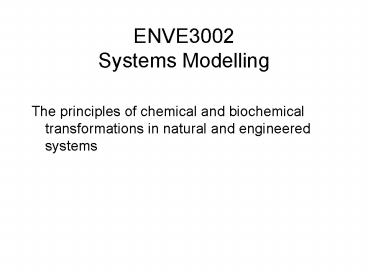ENVE3002 Systems Modelling - PowerPoint PPT Presentation
1 / 41
Title:
ENVE3002 Systems Modelling
Description:
... also the easiest aspect of non-ideality to observe by tracer stimulus-response experiments. ... Chapter 11 Quantitative analysis of non-ideality ... – PowerPoint PPT presentation
Number of Views:56
Avg rating:3.0/5.0
Title: ENVE3002 Systems Modelling
1
ENVE3002 Systems Modelling
- The principles of chemical and biochemical
transformations in natural and engineered systems
2
Basic principles
- Conservation of mass
- Thermodynamics
- Kinetics
- Fluid behaviour
3
Fluid behaviour
- Types of fluid behaviour in systems
- Completely mixed flow
- Plug flow
- Partially (intermediate) mixed flow
- What is the significance of this behaviour
- When system inputs change?
- When there is a reaction going on?
4
Ideal behaviour
- Ideal mixed flow
- Concentration and temperature the same throughout
system - Mean residence time for molecules space time
- Ideal plug flow
- Concentration and temperature only a function of
distance from inlet (i.e. uniform in a plane ? to
flow) - residence time for all molecules space time
- Thin plugs behave like independent batch reactors
as they go from inlet to outlet
5
(No Transcript)
6
Non-ideal behaviour
- Fig. 11.1 demonstrates flow patterns encountered
in various process equipment that will violate
the ideal assumptions. - Note despite the various idiosynchrasies in Fig.
11.1, our analysis will assume the fluid enters
and leaves the vessel only once, i.e. no
backmixing at inlet and exit the closed vessel
boundary condition.
7
Non-ideal behaviour
- Deviation from the ideal residence time is the
most tangible and quantifiable aspect of
non-ideal behavior. Residence time distribution
(RTD) is also the easiest aspect of non-ideality
to observe by tracer stimulus-response
experiments. - Other aspects are
- State of aggregation of the flowing stream
- Earlines of mixing
8
(No Transcript)
9
(No Transcript)
10
Road map for studying non-ideal behaviour in
reactors
- Chapter 11 Quantitative analysis of
non-ideality - Chp 12 Compartment models to explain gross
malfunctions - Chapter 13 The dispersed plug flow model
- Chapter 14 The tanks-in-series model
11
The age (or residence time) distribution (RTD) of
fluid in the reactor, E
- E is the fraction of exit stream of age between t
and tdt. Thus - Fig 11.6 shows this graphically
12
(No Transcript)
13
How do we determine RTD?
- Stimulus-response introduce a change at the
inlet, observe response at the outlet. - Types of stimulus
- Pulse
- Step
- Periodic
- Random
- Fig. 11.7
14
(No Transcript)
15
The pulse experiment
- Instantaneous introduction of M units (e.g. kg)
of tracer at the reactor inlet. - Monitor concentration at outlet, Cpulse, vs t
- Fig. 11.8 PFR example
- Area under curve has units of kg.s/m3 and is
equal to M/v, (kg)/(m3/s) - Cm/V dmCdV dV vdt (m mass)
16
(No Transcript)
17
E, from pulse experiment
18
(No Transcript)
19
The mean residence time, tmean
20
E? , using non-dimensional time
- Fig. 11.10. tmean, ?1 by definition
21
(No Transcript)
22
The step input experiment
- At t0 start introducing tracer at a
concentration of Cmax (e.g. kg/m3) at the
reactor inlet. - Monitor concentration at outlet, Cstep, vs t,
Fig. 11.11
23
(No Transcript)
24
F, from step experiment
- Normalize the Cstep curve
- (Fig.11.12)
- Relation between E and F curves
- Fig. 11.13
25
(No Transcript)
26
Corrections to Box 6, Chp 11
27
(No Transcript)
28
Fig.11.14 E and F curves PFR, MFR and
arbitrary system
- Note the EC notation on the y axis.
- In the step experiment we used Cmax to normalize
Cstep - In the pulse experiment we used M/v to normalize
Cpulse - The C above is the normalized concentration
- Box 9 summarizes the relation between v, C, M, m,
t, ?
29
Box 9 Chp 11 Levenspiel
- Note the correction for E(v/M)Cpulse
M
30
Example 11.1 RTD from Cpulse
31
(No Transcript)
32
(No Transcript)
33
Conversion in a non-ideal reactor, early or late
mixing
- The early or late mixing depicted in Figures 11.4
and 11.5 can be thought of as different types of
reactors in series as in Fig. 11.17 - Recall the principles for optimal arrangement of
reactors of different types - If 0ltnlt1 keep reactant concentrations as low as
possible MFR first, PFR next, i.e. early mixing - If ngt1 keep concentrations as high as possible,
PFR first, MFR next, i.e. late mixing
34
(No Transcript)
35
Conversion in a non-ideal reactor, macrofluid
behaviour
- Elements (clumps) of fluid act independently as
they go through reactor different residence
time, different concentrations, hence different
reaction rate. - The mean concentration at the exit will be found
by
36
Conversion in a non-ideal reactor, macrofluid
behaviour
- Box (Eqn. 13) formulates the situation using
nomenclature we have developed. - The CA/CA0 or XA terms will come from the batch
performance equations applied individually to
each element of fluid, e.g.
37
Equation 13, Chp 11 Levenspiel
38
Example 11.4 First order reaction in non-ideal PFR
- Cpulse vs time data from Example 11.1
- -rA(0.307 min-1)CA
- Ideal PFR gives CA/CA0 0.01, i.e. XA0.99
- The reactor with E from Example 11.1 gives
- CA/CA0 0.0469, i.e. XA0.9531
39
(No Transcript)
40
(No Transcript)
41
(No Transcript)

